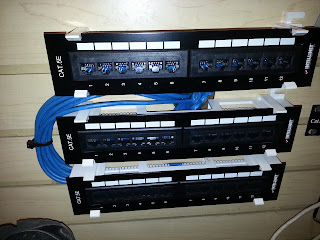It has been some time since I ran the CAT6 cabling around my home. I used angle brackets to mount my 24 port CAT5e patch panel to the top of my network cabinet. I used double sided tape to mount an 8 port switch (that will be eventually be replaced with a GB switch. All CAT6 patch cords are used.
I mounted my easa-phone 308 phone system to one side of the cabinet.
More wiring and mounting of hardware needs to be completed, and the jacks still need to be terminated, labeled and CERTIFIED.
Progress is not too bad, considering this is only getting done on weekends in between errands. So far the total cost for my LAN is at $0. Well that is a little deceptive, I did purchase the 8 port switch, but it was a few years ago. The CAT6 cabling, patch cords and panel, as well as the CAT6 inserts (that I need to install on the jack end of the wiring) was donated by my uncle when he retired. The Panasonic phone system was removed from a customers location when their network was updated, and they were discarding it.
UPDATE 5-1-13:
Still have not had a chance to punch down the jack ends of the network, but I got the HID end of things set up over the past weekend.
Mounted up the 3 monitors. So far only 1 is connected, but then again I only have 1 of the PCs working right now. I had 2 1/2 PC failures and the other 2 have not been tested (and one of those has Asterisk installed, so wouldn't be a workstation PC)
...further updates to follow...













